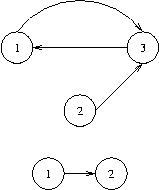Description
We will use the following (standard) definitions from graph theory. Let V be a nonempty and finite set, its elements being called vertices (or nodes). Let E be a subset of the Cartesian product V×V, its elements being called edges. Then G=(V,E) is called a directed graph.
Let n be a positive integer, and let p=(e1,...,en) be a sequence of length n of edges ei∈E such that ei=(vi,vi+1) for a sequence of vertices (v1,...,vn+1). Then p is called a path from vertex v1 to vertex vn+1 in G and we say that vn+1 is reachable from v1, writing (v1→vn+1).
Here are some new definitions. A node v in a graph G=(V,E) is called a sink, if for every node w in G that is reachable from v, v is also reachable from w. The bottom of a graph is the subset of all nodes that are sinks, i.e., bottom(G)={v∈V|∀w∈V:(v→w)⇒(w→v)}. You have to calculate the bottom of certain graphs.
Let n be a positive integer, and let p=(e1,...,en) be a sequence of length n of edges ei∈E such that ei=(vi,vi+1) for a sequence of vertices (v1,...,vn+1). Then p is called a path from vertex v1 to vertex vn+1 in G and we say that vn+1 is reachable from v1, writing (v1→vn+1).
Here are some new definitions. A node v in a graph G=(V,E) is called a sink, if for every node w in G that is reachable from v, v is also reachable from w. The bottom of a graph is the subset of all nodes that are sinks, i.e., bottom(G)={v∈V|∀w∈V:(v→w)⇒(w→v)}. You have to calculate the bottom of certain graphs.
Input
The input contains several test cases, each of which corresponds to a directed graph G. Each test case starts with an integer number v, denoting the number of vertices of G=(V,E), where the vertices will be identified by the integer numbers in the set V={1,...,v}. You may assume that 1<=v<=5000. That is followed by a non-negative integer e and, thereafter, e pairs of vertex identifiers v1,w1,...,ve,we with the meaning that (vi,wi)∈E. There are no edges other than specified by these pairs. The last test case is followed by a zero.
Output
For
each test case output the bottom of the specified graph on a single
line. To this end, print the numbers of all nodes that are sinks in
sorted order separated by a single space character. If the bottom is
empty, print an empty line. 

Sample Input
3 3 1 3
2 3
3 1 2 1 1 2 0
Sample Output
1 3 2
题目大意,一个点所能到达的任意一个点都能返回这个点,那么这个点称为bottom点,找出所有的底部点。
找出所有的强连通子图,每一个子图看作一个点,若该点与其他点有路可达,在该店所代表的所有结点都不符合定义,及输出所有
#include <iostream> #include <algorithm> #include <cstring> #include <cstdio> #include <vector> #include <queue> #include <stack> #include <cstdlib> #include <iomanip> #include <cmath> #include <cassert> #include <ctime> #include <map> #include <set> using namespace std; #pragma comment(linker, "/stck:1024000000,1024000000") #define lowbit(x) (x&(-x)) #define max(x,y) (x>=y?x:y) #define min(x,y) (x<=y?x:y) #define MAX 100000000000000000 #define MOD 1000000007 #define pi acos(-1.0) #define ei exp(1) #define PI 3.1415926535897932384626433832 #define ios() ios::sync_with_stdio(true) #define INF 0x3f3f3f3f #define mem(a) ((a,0,sizeof(a))) typedef long long ll; int pos[5006],vis[5006],low[5006],dnf[5006]; int ans[5006],cnt[5006],degree[5006]; int n,m,x,y,k,top,num,inf; vector<int>v[5006]; void init() { k=0; top=0; num=0; for(int i=0;i<=n;i++) v[i].clear(); memset(vis,0,sizeof(vis)); memset(pos,0,sizeof(pos)); memset(ans,0,sizeof(ans)); memset(cnt,0,sizeof(cnt)); memset(dnf,0,sizeof(dnf)); memset(low,0,sizeof(low)); memset(degree,0,sizeof(degree)); } void tarjan(int u) { dnf[u]=low[u]=++k; pos[++top]=u; vis[u]=1; for(int i=0;i<v[u].size();i++) { if(!dnf[v[u][i]]) { tarjan(v[u][i]); low[u]=min(low[u],low[v[u][i]]); } else if(vis[v[u][i]]) low[u]=min(low[u],dnf[v[u][i]]); } if(low[u]==dnf[u]) { num++; while(1) { inf=pos[top--]; ans[inf]=num; vis[inf]=0; if(inf==u) break; } } } void dfs(int u) { cnt[u]=ans[u]; for(int i=0;i<v[u].size();i++) { if(ans[u]!=ans[v[u][i]]) degree[ans[u]]++; if(!cnt[v[u][i]]) dfs(v[u][i]); } } void solve() { for(int i=1;i<=n;i++) if(!dnf[i]) tarjan(i); for(int i=1;i<=n;i++) if(!cnt[i]) dfs(i); bool flag=1; for(int i=1;i<=n;i++) { if(!degree[ans[i]]) { if(flag) {printf("%d",i);flag^=1;} else printf(" %d",i); } } printf(" "); } int main() { while(scanf("%d",&n) && n) { scanf("%d",&m); init(); for(int i=0;i<m;i++) { scanf("%d%d",&x,&y); v[x].push_back(y); } solve(); } return 0; }
出度为0的连通子图所包含的点